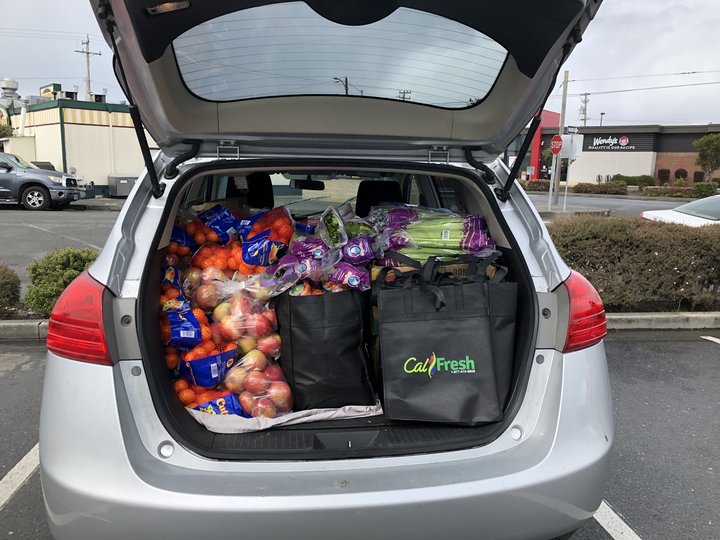
A Paso a Paso vehicle loaded with produce and ready to make the delivery rounds to its local Latinx and Hispanic clients. Photo: Submitted.
###
Standing in Eureka’s La Pasadita Market on a recent afternoon, Isabel Ortiz says she’s had a hard time getting information on COVID-19, how to prevent its spread and what to do if she or someone she knows starts experiencing symptoms. Ortiz, who works at the market, only speaks Spanish and most of the COVID-19 information she’s seen has been in English. She says it would be a good idea for local officials to translate important information for those in the Latinx and Hispanic communities who don’t speak English. She says she’d been planning to go to Eureka City Hall to ask for some but hadn’t had the chance yet.
But even if Ortiz had made it there, she wouldn’t have found much in Spanish, as City Clerk Pam Powell says the city just sends folks looking for COVID-19 information to Humboldt County Public Health’s website, adding that the department also has interpreters on staff who could help people find information.

Officials believe stories like Ortiz’s may help explain why at least 22 percent of local confirmed COVID-19 cases have been found in Latinx and Hispanic community members, even though they make up just 12.2 percent of the local population. Humboldt County’s white residents, meanwhile, account for 83 percent of the population but just 44.3 percent of confirmed COVID-19 cases.
In a recorded Q&A with the local media late last month after Humboldt County first released COVID-19 case data broken down by ethnicity and race, Health Officer Teresa Frankovich said the disparity is not lost on officials.
“Locally, the most dominant effect is a disproportionate amount of cases in our Latinx community and to that issue we have been really trying to work on outreach to the community,” Frankovich said. “Obviously, there may be language barriers and so we’re really trying to address that, and really trying to get information out so that people are aware of what precautions need to be taken and what they can do if they become ill.”
But Frankovich’s message might not be getting through to those in most urgent need of the information.
Engelberto Cejeda, who owns El Pueblo Panaderia, says that the problem is that there aren’t any places he can find Frankovich’s media availabilities translated in Spanish, or even an outlet that’s a clear channel for translated COVID-19 information.
“I turn on the television and try to watch the local news, but I can’t understand,” Cejeda says. “It would be nice to see [Frankovich’s reports] translated into Spanish. It doesn’t have to be everyday. It can just be on weekends.”
According to Meriah Miracle, who supervises Humboldt’s COVID-19 information call center, the county has two Spanish speaking representatives available every hour that the call center is open, adding that these representatives help translate frequently asked questions and walk callers through information on the Humboldt County homepage to find translated fliers that can be shared on social media. These interpreters also work with Public Health on contact investigations involving Spanish-speaking residents, she says.
The Latinx and Hispanic communities aren’t the only ones locally who face a language barrier. According to the U.S. Census, 11.8 percent of Humboldt County households speak a language other than English at home, including 6.8 percent that are Spanish speaking households. According to the Humboldt County Office of Education, 2,000 of Humboldt County’s approximately 16,000 K-12 students come from households where English is not spoken at home. Recognizing the information gap, a group of Lao and Hmong volunteers translated COVID-19 fliers and fact sheets from Public Health and included paper copies in a massive food distribution effort to those communities in May.
Humboldt County is far from unique in seeing case disparities. Statewide, Latinx and Hispanic people account for 55 percent of COVID-19 cases, while only making up 39 percent of the state’s population. Nationally, they account for 33.5 percent of cases, according to the Centers for Disease Control, but just 18.5 percent of the population. Additionally, data indicates they disproportionately face critical outcomes and death as a result of the disease. The data is also limited to people who self-reported race or ethnic information on a questionnaire at the time of testing, which, in Humboldt County, 40 percent of positive cases did not, according to Miracle.
Nonetheless, there is ample evidence large disparities exist and a language barrier is only one possible reason, according to Caterina Kein, program supervisor for Paso a Paso, which is run through St. Joseph Health and offers support services to the county’s Latinx and Hispanic populations.
“When we’re looking at those who are disproportionately affected by COVID, then we also know that there are underlying health conditions,” Kein says. “And not just physical health, but also mental health and whole health, as well — housing stability, economic health and access to care are all variables that make people more vulnerable to essentially contracting COVID.”
In Humboldt County, Latinx and Hispanic households are more likely to live below the poverty line than their white counterparts, and half as likely to own a single-family home. And while Hispanic and Latinx workers make up 12.7 percent of the local labor force, according to the American Community Survey, they disproportionately fill the types of service sector jobs that can lead to more COVID-19 exposure and were hardest hit by initial layoffs.
“With the decline of service industry jobs, we are looking at additional financial, economic and housing barriers to families that may not be able to access state and federal benefits or safety net programs due to their documentation status,” Kein says.
And the disease and reverberating impacts have only exacerbated existing inequities, as Kein notes that some of the families her program serves are “mixed-status” families — families that have documented and “questionably documented” people in their households — and thus may have been left out of the federal stimulus funding measures and don’t receive other benefits.
The economic disparities only serve to widen the information gap, Kein says, explaining that barriers that existed before the pandemic are now enhanced. She says some of the more rural Latinx populations don’t have access to broadband internet and are dependent on pre-paid data cell phones, meaning some have to choose between staying in touch with families or researching health and safety information.
Across all demographics, 19 percent of Humboldt County residents don’t have internet at home and 10 percent don’t have a computer, according to the Census, rendering simple self-diagnostic COVID-19 tools and other crucial information inaccessible.
Paso a Paso’s bilingual staff — which for 20 years has worked to provide childbirth education, breastfeeding support, parenting classes, home visits, resources referrals and support groups — is keeping up with its participants to brief them on developing COVID-19 information through phone calls, text messages, Zoom classes and doorstep drop-offs. However, that effort only extends to program participants, which total 4,212 to date this year.
The program is also helping its participants obtain personal protective equipment, teaching about health and safety precautions, and how to navigate the new tele-health doctor visits. Some clients who are homebound due to job losses or illnesses get assistance with grocery runs for necessities like food and household items.
Like Paso a Paso, Open Door Community Health Centers — the largest local healthcare provider — is working to get information to the Spanish speaking community.
Open Door’s Latino Health Coordination Program has dedicated staff in Humboldt and Del Norte counties who work to develop relationships in the Latinx communities, CEO Tory Starr said in an email.
Starr said the health system uses a Promotores de Salud model for patient connection, which sees Spanish-speaking staff offer Spanish speakers a swath of services, from translation to health education. Additionally, Starr said Open Door is collaborating with St. Joseph Hospital and area nonprofits to try to ensure Spanish-speaking patients have all the help they need to access educational materials, testing, community resources and coordinated care, as well as to participate fully in Public Health contact tracing efforts.
Jennifer
Judge, Open Door’s member services programs manager, said the
clinic’s partnership with Public Health also makes it so Open
Door’s staff can help Spanish speakers who have tested positive for
COVID-19 with whatever they need for care coordination and recovery.
For example, if they don’t have health insurance, Open Door staff
helps them obtain it. Starr said it’s simply vital for Open Door
staff to be as connected as possible to provide Latino patients, as
well as the broader community, with services that are “culturally
and linguistically appropriate.”
“The
language barrier issue is more complicated than simply providing
materials in Spanish; materials that are created for the mono-lingual
English speaking community may not take into account access to
resources, health literacy and a number of other social determinants
of health factors,” he said.
In
her own experience, Judge says she knows what it was like to be an
interpreter for her mom during doctor visits and parent-teacher
conferences.
“I
understand that sometimes you don’t have all the tools to provide
people with the information in their preferred language but health is
very important, and to communicate that in their language and set
them up for the same opportunities that anyone that speaks English
has is very valuable,” she says.
As
Starr and Judge point out, effective outreach to the the nearly 12
percent of local households that don’t speak English at home is a
challenge that requires extensive outreach in addition to
translation, as non-English speakers are unlikely to visit the
county’s website or follow the Joint Information Center on social
media. But it may prove a crucial component of making sure the Latinx
and Hispanic communities don’t continue to suffer disproportionate
impacts of a deadly disease.
During
another recent media Q&A, Frankovich said the Joint Information
Center’s goal is to reach out to the Latinx community.
“In
a community where English may not be the first language, it’s
really challenging to make sure people have the information they need
to make the decisions and to understand how to access, for instance,
testing and services they need,” she said. “It’s certainly been
a target for our Joint Information Center in terms of trying to reach
out in all kinds of avenues to get people that information in the
language that’s appropriate, and I’m hoping we’re making
headway in that respect.”
###
The Community Voices Coalition is a project funded by Humboldt Area Foundation and Wild Rivers Community Foundation to support local journalism. This story was produced by the North Coast Journal newsroom with full editorial independence and control.
CLICK TO MANAGE